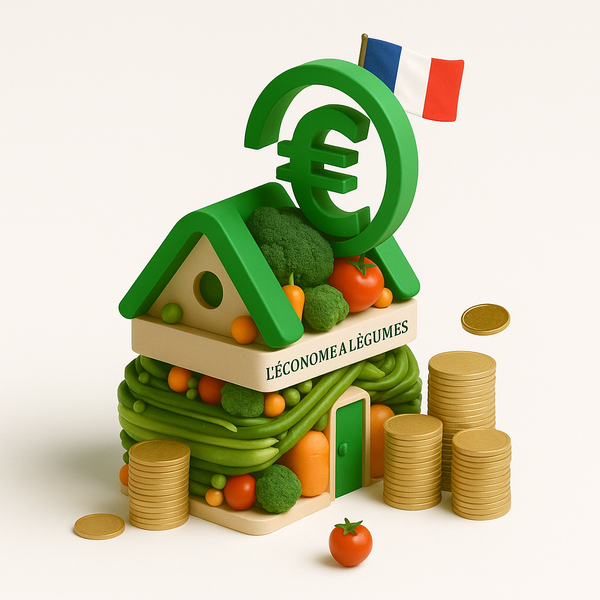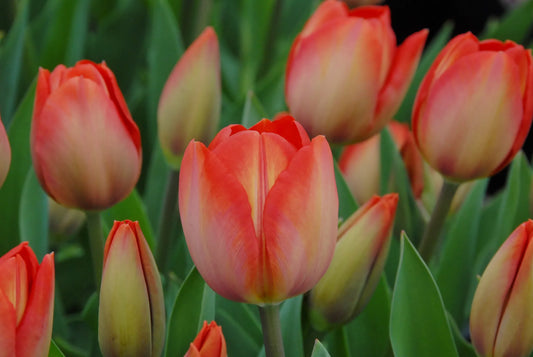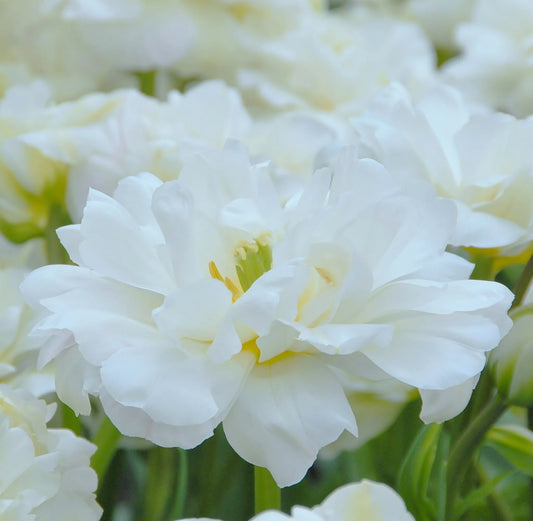-
Livraison dès 10 bulbes France, Suisse et Europe
Modalité livraison -
Grossiste Bulbes de fleurs en ligne
-
Bulbes de Qualité
-
Paiement sécurisé
Virement / chèques / Carte Bancaire /Chorus
Untreated Flower Bulbs Spring Bubbles Mix (9000800) for Individuals
Untreated Flower Bulbs Spring Bubbles Mix (9000800) for Individuals
PRICE per bulb € excluding VAT excluding transport
Free shipping on orders of 400 or more bulbs! 0.1€ discount per bulb on orders of 100 or more bulbs of all varieties.
Delivery from mid-September to November - choice at the basket stage
Online shopping available in France and Belgium. For other countries, please request a quotation.
Couldn't load pickup availability
 Limited stock - Buy now and get it delivered when you're ready to plant
Limited stock - Buy now and get it delivered when you're ready to plant
- Delivery from 10 bulbs to France, Switzerland and Europe
Flower Color:
Usage:
Flowering:
View full details
Quality Flower Bulbs for Floriculturists and Individuals
Quick read / the essentials about our Flower Bulbs
Are you a florist or flower producer in France? Floriverse supports you as a wholesale supplier specializing in Flower Bulbs , offering you a wide selection of professional bulbs: certified organic, untreated or conventional. Each bulb is selected according to precise agronomic criteria: size, uniformity, flowering potential and post-harvest behavior. Buying Flower Bulbs through our network means choosing responsive logistics, decreasing prices and technical support dedicated to your cultivation objectives.
Our offer covers all spring and summer flowering species intended for cut flowers, direct sales, or landscaping. Thanks to our experience in the French market and sourcing exclusively from specialized producers, we bring you reliability, performance and traceability. As a wholesale supplier specializing in flower bulbs , Floriverse guarantees optimal implementation, fast deliveries and ready-to-produce bulbs.
The market is evolving: relocation, short supply chains, environmental requirements... Buying Flower Bulbs from Floriverse means integrating these trends with concrete solutions, whether it's bulbs for staggered flowering, naturalization, indoor cultivation or organic production. Our teams are at your side to plan, advise and adapt volumes to your projects. Floriverse, your specialist wholesale supplier of Flower Bulbs , is committed to providing you with high-performance bulbs adapted to the realities on the ground.
Whether you're looking to sell to florists, dried flowers, or cultivate them sustainably in open fields, buying flower bulbs has never been more strategic.
Wide range of flower bulbs for professional florists
Our catalog is aimed at floriculture professionals looking for a wide range of flower bulbs , selected for their agronomic performance, their regularity of flowering and their adaptability to different growing methods. We offer three types of products: certified organic flower bulbs , untreated bulbs and conventional bulbs , sourced exclusively from specialized producers. Each batch is checked for its sanitary quality, size and homogeneity, guaranteeing reliable establishment and optimal flowering. Our range covers all needs in seasonal cut flowers, landscape plants and floral production in open fields or under cover.
Flower bulb cultivation in France: market context and professional dynamics
Between 2022 and 2025, the French cut flower market will undergo a profound transformation, driven by a growing desire to relocate production and reduce dependence on imports. In 2022, these represented more than 320 million euros, with a national share still marginal (around 8% of the available supply). However, demand for traceable, local, and eco-responsible flowers is intensifying, opening up concrete opportunities for the cultivation of flower bulbs in France.
The productive fabric remains concentrated, with only 400 specialized farms out of 2,761 ornamental horticulturists recorded. Nevertheless, a diversification dynamic is taking hold, with the emergence of flower farms and multi-workshop producers integrating bulb flowers into their crop rotation. The PACA, Pays-de-la-Loire and Île-de-France regions concentrate the majority of dedicated areas, with a growing interest in species with high added value and good vase life.
The organic segment remains marginal but structuring for certain circuits: it is driven by a clientele sensitive to agroecology, strict seasonality and short supply chains. Conversely, the conventional market continues to dominate in volume, particularly via wholesale channels and sales to florists, but is gradually moving towards greater transparency (labels, traceability, French origin). Flower bulbs fit perfectly into this logic, offering a product that is easily stored, mechanized and has strong decorative potential.
Technical and logistical support for the success of your plantations
We support you in setting up your crops thanks to a complete and structured offer around flower bulbs at producer prices . Our short circuit model guarantees you a simple and fluid agricultural supply , with dedicated technical support and proven commercial responsiveness : responses and quotes within 48 hours, without obligation. Our customers can request personalized quotes accompanied by free advice and a complete technical itinerary , adjusted according to their production objectives (cut flowers, sale in bunches, bouquet flowers, dried flowers, etc.).
Delivery is guaranteed throughout France , generally within 15 days in season, with careful preparation to guarantee the integrity of the bulbs upon receipt. It is possible to book in advance to anticipate the availability of the most sought-after varieties. Our bulbs are grown by specialized nurseries according to strict specifications. Prices are reduced according to volume, to adapt to diversified structures as well as specialized farms.
As a specialist in flower bulbs and a partner of floriculturists , we do everything we can to guarantee unbeatable value for money , quality advice and reliable logistics. Our goal: to make your bulb flower crops profitable, competitive and adapted to the new requirements of the French market.
Professional production of flower bulbs
Bulb plants represent an essential and versatile category in the professional horticultural sector. Belonging to the group of geophytes, they are characterized by the presence of fleshy underground organs that serve as nutrient reserves to survive adverse seasons, whether winter cold or summer drought. These specialized structures allow for an adapted life cycle, offering spectacular flowering often at the beginning or end of the season, and constituting an important source of income for growers and a key decorative element for landscapers. Understanding the technical nature of these organs and flowering is fundamental to optimizing their cultivation, marketing, and use in landscaping projects or for the production of cut flowers.
Technical classification of reserve organs
Although often grouped under the generic term "bulbs", the plants concerned can have different types of underground storage organs, each with its own morphological and physiological characteristics.
Tunicate bulbs - Classic structure
The most classic form is the tunicate bulb , composed of concentric fleshy scales enveloped by a thin, protective outer tunic. This type of bulb stores nutrients and the embryo of the future plant. It is typical of many major species for professionals, such as Allium (ornamental garlic), Galanthus (snowdrops), Hyacinthoides (bluebells), Scilla, and Tulips. The tunic, usually light to medium brown in color, protects the inner whitish scales. The bulb ends at its base with a plate from which the roots extend.
Corms and tubers - Morphological variants
Some species, such as Arum italicum, grow from corms , which are swollen, strong underground stems protected by a tunic. The main tuber of Arum italicum is about 4 cm in diameter and is often accompanied by numerous smaller tubers.
Tubers , on the other hand, are modified stems or roots, often irregular in shape. Corydalis, for example, may have a solid (Corydalis solida) or hollow (Corydalis cava) tuber, ranging from ovoid to globose or spherical in shape, measuring between 10 and 30 cm in height for the flowering plant. Some species of Oxalis are also described as having tubers, in addition to bulbs and rhizomes. The bulbs of Oxalis triangularis are described figuratively as "tiny immature pine cones."
Rhizomes - Horizontal extension
Rhizomes are horizontal underground stems that allow the plant to spread. Convallaria majalis (lily of the valley), for example, is a rhizomatous perennial herb that forms a dense, spreading groundcover.
Professional calibration
For professionals, accurate identification of the reserve organ is crucial for adapting cultivation techniques, including planting depth and vegetative propagation management. Bulb size (calibre), measured in circumference, is also a key technical indicator of vigour and flowering potential. For example, Lilium orientalis bulbs of 14/16 calibre are recommended. For Scilla siberica, a calibre of 8/+ cm ensures good flowering in the first year. Tulip bulbs of 12/+ calibre are preferred for robust flowering.
Crop cycle management and longevity
Botanically, the majority of bulb plants are perennials. They persist from one year to the next thanks to their underground storage organ. The typical cycle includes a period of vegetative (leaves) and floral (flowers) growth followed by a period of foliage senescence and dormancy during the unfavorable season. During this dormancy, the nutrient reserves stored in the bulb allow the plant to survive.
However, in professional cultivation, particularly for hybrid varieties with high ornamental value or for cut flowers, many species, such as tulips, are often treated as short-lived perennials , or even annuals. Flowering is most spectacular in the first year after planting. In subsequent years, flower vigor and size can decline rapidly, making annual or biennial bulb replacement necessary to maintain consistent production quality. Lily of the valley is also mentioned without precise data on its longevity in professional cultivation, requiring specialist information. In contrast, species such as Camassia are described as perennials, returning year after year with little maintenance and forming flowering colonies over time. Persistence in place can vary from 3 to 5 years , or even up to 10 years for some botanical tulips, but this is not the norm for commercial production. Lilium bulbs often require renewal every 3-4 years .
Managing this cycle is essential: the foliage must be kept after flowering until it turns yellow naturally to allow the bulb to replenish its reserves through photosynthesis. Cutting the foliage too early harms future flowering.
Technical floral characteristics
The flowers produced by bulb plants offer an incredible diversity of shapes, sizes, colors and sometimes fragrances, which explains their success with professionals.
Floral morphology
Floral forms vary considerably. There are bell-shaped or campanulate flowers (Erythronium, Convallaria, Leucojum, Scilla), star-shaped flowers (Allium, Camassia, Chionodoxa, Ornithogalum, Puschkinia), cup-shaped or goblet-shaped flowers (Winter Aconite, Bulbous Iris with their drooping sepals and upright petals, Sternbergia, Tulips), funnel-shaped flowers (Lilium), or the very specific spathe and spadix structure of Arum italicum.
Commercial sizes and dimensions
The dimensions are very variable, ranging from small flowers 0.5 to 1 cm long in Muscari or 5 to 10 mm in diameter in Lily of the Valley, to much more imposing flowers or inflorescences. The umbels of ornamental Allium can reach 2 to 25 cm in diameter , the individual flowers of Lilium can be very large, those of bulbous Iris 6 to 12 cm in diameter , those of Gladiolus up to 10 cm , and the spathe of Arum italicum measures about 30 x 15 cm . The height of the flower stems is also an important technical criterion, ranging from 7 to 10 cm for Aconite to 90 cm for Gladiolus or even more than 1.50 m for Allium giganteum.
Professional color palette
The color palette of bulbs is extremely rich. We find bright yellows (Winter Aconite, Sternbergia, Narcissus), pure whites (Erythronium, Galanthus, Leucojum, Lilium candidum, Ornithogalum, Anemones), a wide range of blues and purples (Allium, Camassia, Chionodoxa, Hyacinthus, Iris, Muscari, Puschkinia, Scilla), pinks and purples (Allium, Anemones, Convallaria (rarely), Hyacinthus, Lilium, Muscari, Tulips). Tulips offer the greatest variety of colors and patterns.
Olfactory criteria for marketing
Fragrance is a variable criterion. Some species are known for their powerful and pleasant fragrance , such as lily of the valley (very fragrant, sweet) or hyacinth (very fragrant, intoxicating). Oriental Liliums are known for their intoxicating fragrance . Other species have a light fragrance (Galanthus, Ipheion, Muscari, Puschkinia, Narcissus), while many are considered unscented or with a very discreet fragrance (Erythronium, Winter Aconite, Camassia, Leucojum, Ornithogalum, Sternbergia, Tulips, most ornamental Alliums). For professionals in the cut flower or sensory space design sector, this criterion is decisive.
Flower yield per unit
This characteristic influences the visual impact of the plant. Many species have a single flower per stem (Erythronium, Winter Aconite, Galanthus, Sternbergia, Leucojum vernum, most daffodils, and most tulips). Other species bear several flowers on the same stem or in inflorescence (Allium: umbels of tens to hundreds of flowers, Arum italicum: spadix covered with tiny flowers, Camassia: clusters of 20 to 80 flowers , Chionodoxa: clusters of small flowers, Convallaria: clusters of 5 to 15 bells , Hyacinthus: dense cluster of several dozen florets, Ipheion: several flowers per foot, but often one per thin stem, Bulbous iris: 1 to 3 flowers per stem , sometimes 5, Leucojum aestivum: umbel of 3 to 7 flowers , Lilium: several flowers per stem, Muscari: clusters of 20 to 40 bells , Ornithogalum: clusters of 5 to 20 flowers , Puschkinia: racemes of 3 to 6 flowers , Scilla: 3-5 flowers per stem , certain Tulips).
Technical foliage management
The foliage of bulb plants is generally simple, linear to lanceolate in shape, often emerging directly from the bulb in a basal rosette. Its color varies from medium to dark green, often with a smooth and sometimes glossy texture. Its presence is essential for photosynthesis , which allows the plant to store nutrient reserves in the bulb for future flowering.
The duration of foliage presence is technical. For the majority of species, it is deciduous , disappearing in autumn-winter. However, some species have particularities. Lilium candidum, for example, has a reversed cycle with a basal rosette persisting in winter, entering summer dormancy. Camassia leaves persist throughout flowering until seed formation, and Hyacinthus leaves remain present until they fade completely after flowering. Ornithogalum may have a white band on the upper surface of their leaves.
The ornamental value of foliage after flowering is generally limited for most species, with the major decorative value being concentrated in the flowers. However, its preservation is crucial for the health and flowering of the following year.
Professional applications and commercial development
Flower bulbs offer many advantages for florists, nurserymen, professional flower producers, town halls, green space services, private estate managers, landscapers, park and garden managers, and horticultural managers.
Cultural advantages and hardiness
Many species are known to be easy to grow , tolerant and hardy, adapting well to French climates. Their resistance to adverse conditions, including cold for some (Scilla, certain botanical tulips), or drought (certain Allium, Lilium), reduces the need for maintenance and replacement.
Staggering of flowering
By carefully selecting species and cultivars, it is possible to offer staggered flowering from early winter (Aconite, some Ipheion) to mid-summer (Gladiolus, Lilium) and even into autumn (Sternbergia, Arum italicum for its berries). This diversity helps maintain visual interest in flowerbeds or ensure a continuous supply for cut flowers.
Mass plantings and naturalization
Many species are ideal for mass plantings , naturalized meadows, or large public spaces. Their ability to naturalize (multiply and spread) over time (Galanthus, Scilla, Puschkinia, Leucojum) reduces maintenance and renewal costs. Asiatic Lilium, for example, are hardy, easy to grow, and require little maintenance .
Production of cut flowers
This is a major market for bulbs. Species such as Tulips, Narcissus, Hyacinths, Lilium, Gladiolus, Italian Anemones, Ipheion, Leucojum, and Ornithogalum are widely used. Key technical criteria are stem length and stiffness (Gladiolus and Lilium often suitable, Ipheion more limited, Tulips curving after cutting), vase life (Gladiolus and Ornithogalum dubium excellent, Ipheion shorter, Tulips about a week), and the desired fragrance for certain compositions.
Forcing techniques
The forcing technique allows for off-season flowering, particularly for galanthus and tulips. This is a commercial advantage for offering "early blooms." It is important to note that forcing exhausts the bulbs, which generally will not flower again the following year.
Phytosanitary surveillance
Professionals must be vigilant for potential problems. Drainage is essential to prevent bulb rot. Specific pests, such as the lily leaf beetle (Lilioceris lilii) on Lilium, require appropriate monitoring and management. Visual (bulb appearance, leaves, stems) and physiological indicators can be used to assess plant health and detect deficiencies or stress.
To summarize: Our Flower Bulbs
As a specialist wholesale supplier of Flower Bulbs , Floriverse offers a complete, reliable and accessible solution to French floriculturists. Our bulbs are certified, controlled and ready to meet the expectations of a changing market, increasingly focused on traceability, French origin and responsible practices. Whether you produce under cover or in the open field, organic or conventional, our offer allows you to buy Flower Bulbs at the best quality-price ratio, with tailor-made support.
Our expertise covers all technical aspects: choice of size, varietal selection, growing routes, planting calendar, vase life, naturalization potential... We help you build a coherent and profitable range, adapt your production to local demand and secure your plantations thanks to effective commercial monitoring. As a wholesale supplier specializing in Flower Bulbs , we are at your side to maximize your profitability while respecting your constraints.
Thanks to our optimized logistics, fast quotes, and free advice, buying flower bulbs with Floriverse saves time, improves reliability, and improves performance. Our team helps you anticipate demand, reserve your batches, and integrate best practices into your growing calendar. Recognized by many growers in France, Floriverse has established itself as a trusted wholesale supplier specializing in flower bulbs , dedicated to your success.
Buying Flower Bulbs becomes a strategic and technical process, facilitated by the experience and responsiveness of Floriverse.
-
Untreated flower bulbs Cyclamen coum ssp. coum size 13/15 (3231000)
Regular price €0,75 EURRegular priceUnit price / per -
Untreated flower bulbs Sternbergia lutea size 10/12 (3890100)
Regular price €0,42 EURRegular priceUnit price / per -
Untreated flower bulbs Tulip Orange van Eijk® size 12/+ (1011600)
Regular price €0,25 EURRegular priceUnit price / per -
Untreated Tulip Mount Tacoma Flower Bulbs Size 12/+ (1011000)
Regular price €0,36 EURRegular priceUnit price / per -
Untreated flower bulbs Allium scorodoprasum Art® size 5/7 (3129500)
Regular price €0,14 EURRegular priceUnit price / per
Floriverse: Online wholesaler of flower bulbs
-
-
Wholesale Flower Bulbs Online
We work with dozens of producers to offer you the best prices for your flower bulbs.
-
Quality
Our producers are selected for their reliability and the quality of their bulbs.
-
Your bulbs at the best prices
We work every year with your partner producers to offer you the best prices






